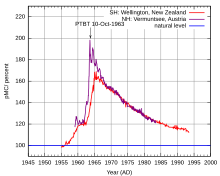Treaty on the Prohibition of Nuclear Weapons Tests in the Atmosphere, in Space and Underwater

The Treaty on the Prohibition of Nuclear Weapons Tests in the Atmosphere, Space and Underwater , also the Moscow Nuclear Test Ban Treaty , often abbreviated as LTBT ( Limited Test Ban Treaty ), NTBT ( Nuclear Test Ban Treaty ) or PTBT ( Partial Test Ban Treaty ), but not be confused with the agreement of the comprehensive test ban Treaty ( comprehensive test ban Treaty ) was opened for signature on 5 August 1963 and entered on October 10, 1963 in force. It was originally closed between Great Britain , the Soviet Union and the USA . Of the remaining states with nuclear weapons , India (1963), Israel (1964) and Pakistan (1988) signed the treaty. The Federal Republic of Germany signed the nuclear test ban treaty on August 19, 1963.
The treaty prohibits nuclear weapons tests and other nuclear explosions carried out in the atmosphere , in space and under water (territorial waters and high seas ), as well as explosions that cause fallout to travel outside the boundaries of the country that carried out the explosion.
Its creation during the Cold War was also motivated by the worrying increase in radioactivity in the earth's atmosphere that was observed at the time . This increase was due to nuclear weapon explosions, which had taken place in large numbers as part of military test programs of the great powers until the early 1960s. A 1958 by the biochemist Herman Moritz Kalckar excited study had also shown that the content of the radioactive fallout - isotope strontium -90 in primary teeth had increased dramatically from children at the height of the nuclear weapons tests; a factor that correlates with an accumulation of early cancers . The main objective of the treaty was therefore to prevent the release of the radioactive fallout associated with nuclear weapons tests and thus also to contain the arms race . The latter went on almost unchecked, but test explosions by the contracting parties now always took place underground, so that these countries no longer generated any further fallout.
Great Britain carried out the last atmospheric test on September 23, 1958, the USA on June 9, 1963 and the USSR on December 25, 1962. The radioactivity in the atmosphere, which had risen to almost twice the natural level, has therefore ceased since the treaty entered into force back.
Only the People's Republic of China and France , which have not yet joined the treaty, continued to test above ground. France carried out 41 tests from July 2, 1966 to September 14, 1974, and China carried out 22 tests between October 16, 1964 and October 16, 1980.
A possible violation of the treaty was a possible nuclear weapons test of Israel and / or South Africa ( Vela incident ) on September 22, 1979 in the southern Indian Ocean, which was discovered by a US Vela satellite .
See also
- Nuclear Test Ban Treaty
- Nuclear Non-Proliferation Treaty
- Bioweapons Convention
- Chemical Weapons Convention
- Nuclear Weapons Convention
Web links
- Contract text ( memento of July 19, 2011 in the Internet Archive ) at the UN (English)
- List of signatory states to the UN (English)
- Nuclear test ban agreement
- Moscow nuclear test ban agreement
Individual evidence
- ^ "Calendar sheet: 50 years of the nuclear test ban treaty", seniorbook in August 2013
- ↑ Herman Kalckar: An International Milk Teeth Radiation Census . In: Nature Publishing Group (ed.): Nature . 182, Aug. 2, 1958, pp. 283-284. bibcode : 1958Natur.182..283K . doi : 10.1038 / 182283a0 . Accessed April 2019.
- ^ Rosenthal HL: Implications of environmental Strontium-90 accumulation in teeth and bone of children. Proceeding of the Sixth Berkeley Symposium on Mathematical Statistics and Probability. University of California Press, 1970; 465-476
- ↑ JM Gould et al .: Strontium-90 in deciduous teeth as a factor in early childhood cancer. . In: Int J Health Serv . 30, No. 3, 2000, pp. 515-539.

